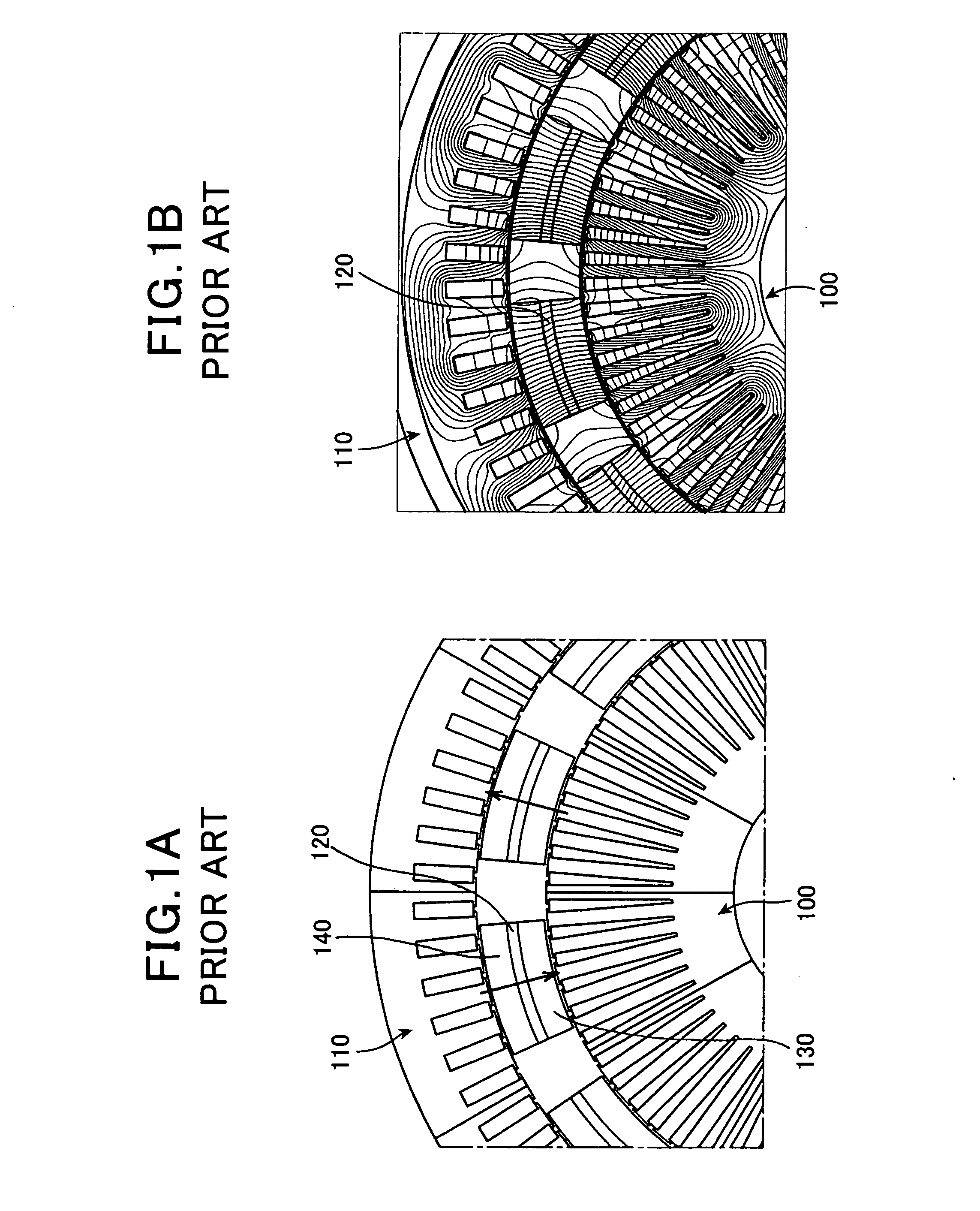Double-stator motor
a double-stator motor and motor technology, applied in the direction of rotating magnets, synchronous machines with stationary armatures, electrical apparatus, etc., can solve the problems of difficult to use these motors in practice, high fabrication cost, and limited installation of motors, so as to reduce the magnetic resistance of the magnetic circuit, suppress the core loss, and reduce the effect of magnetic flux leakag
- Summary
- Abstract
- Description
- Claims
- Application Information
AI Technical Summary
Benefits of technology
Problems solved by technology
Method used
Image
Examples
first embodiment
[0061]Referring to FIGS. 2 to 6A and 6B, a first embodiment of the present invention is described. The first embodiment is an example in which a double-stator motor of the present invention is applied to a motor-generator 1 of a hybrid vehicle.
[0062]FIG. 2 is a cross-sectional diagram illustrating a general configuration of the motor-generator 1. FIG. 3 is a partial cross-sectional diagram illustrating the structure of a principal part of a motor, as the motor-generator 1, according to the first embodiment of the present invention.
[0063]As shown in FIG. 2, the motor-generator 1 includes a rotary shaft 2, a disc holder 3, an annular rotor 4, an inner stator 5 (first three-phase stator of the present invention) and an outer stator 6 (second three-phase stator of the present invention). The annular rotor 4 is connected to the rotary shaft 2 via the disc holder 3 so as to be coaxial with the rotary shaft 2. The inner stator 5 is disposed on a radially inner side of the rotor 4. The oute...
second embodiment
[0099]Referring to FIG. 7, hereinafter is described a second embodiment. In the second and the subsequent embodiments, the components identical with or similar to those in the first embodiment are given the same reference numerals for the sake of omitting explanation.
[0100]FIG. 7 is a partial cross-sectional diagram illustrating the structure of a principal part of a motor according to the second embodiment.
[0101]In the second embodiment, the number of slots of the inner stator 5 is smaller than that of the outer stator 6. Also, each slot 5a1 of the inner stator 5 has a cross section larger than in the first embodiment.
[0102]For example, as shown in FIG. 7, six slots are formed for each pole of the outer stator 6 similar to the first embodiment, while three slots are formed for each pole of the inner stator 5, with the cross section of each of the slots 5a1 being designed to be large.
[0103]In the first embodiment exemplified above, the number of slots of the inner and outer stators ...
third embodiment
[0105]Referring to FIGS. 8A, 88 to 10A, 10B, hereinafter is described a third embodiment of the present invention.
[0106]As described in the first embodiment, the inner and outer stators 5 and 6 have an equal electromotive force in the inventive motor. In addition, the inner and outer stators 5 and 6 are arranged face to face sandwiching the segment poles 7. Therefore, two magnetic flux loops are formed in parallel. As a result, the number of gaps for the magnetic flux to pass is only two regarding one magnetic flux loop.
[0107]Thus, compared to the conventional motor, magnetic resistance of the magnetic circuit is reduced. In order to take advantage of this low magnetic resistance, concentrated winding is used in the third embodiment. In an example of the third embodiment, the three-phase coils of the inner and outer stators 5 and 6 are wound, in a concentrated manner, about the core teeth 5a2 and 6a2 formed in the inner and outer stator cores 5a and 6a, respectively.
[0108]Unlike the...
PUM
 Login to View More
Login to View More Abstract
Description
Claims
Application Information
 Login to View More
Login to View More - R&D
- Intellectual Property
- Life Sciences
- Materials
- Tech Scout
- Unparalleled Data Quality
- Higher Quality Content
- 60% Fewer Hallucinations
Browse by: Latest US Patents, China's latest patents, Technical Efficacy Thesaurus, Application Domain, Technology Topic, Popular Technical Reports.
© 2025 PatSnap. All rights reserved.Legal|Privacy policy|Modern Slavery Act Transparency Statement|Sitemap|About US| Contact US: help@patsnap.com



